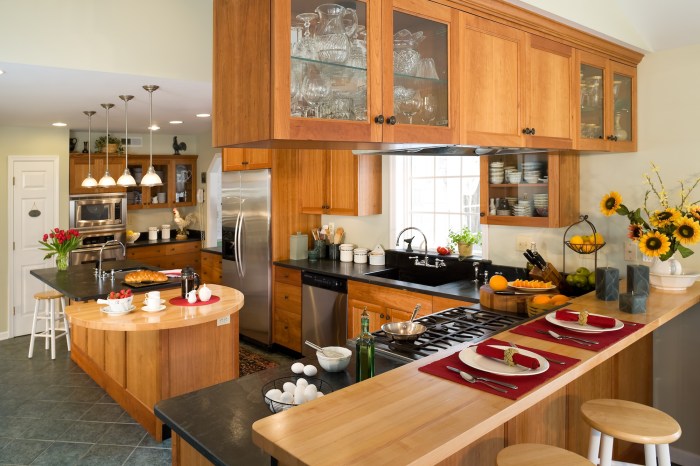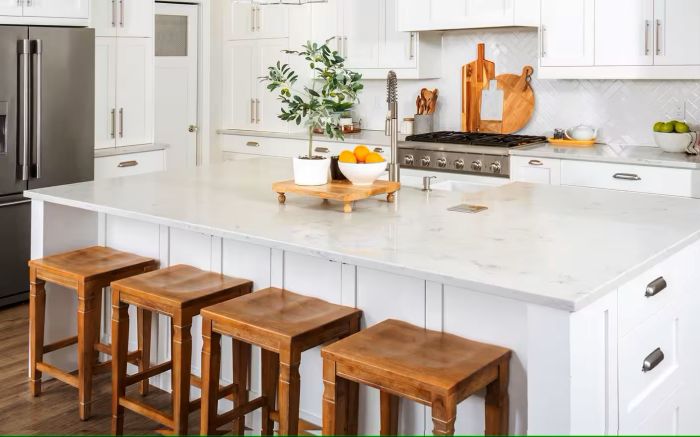Materials and Textures for Countertop Decor

Kitchen counter top decor – Choosing the right materials and textures for your countertop decor can dramatically impact the overall look and feel of your kitchen. The interplay of natural elements and tactile surfaces creates a space that’s both visually appealing and enjoyable to use. Consider the existing style of your kitchen and how different materials can enhance or contrast with your cabinets and backsplash.
Natural Materials in Countertop Decor
Wood, stone, and metal offer a diverse range of options for countertop styling. Wood, whether in the form of a cutting board, a small bowl, or a decorative tray, brings warmth and organic texture. Different wood types, like oak, maple, or bamboo, offer varied grain patterns and colors. Stone, such as marble, granite, or slate, introduces an element of elegance and durability.
So, we’ve been discussing the importance of carefully curated kitchen countertop decor, right? But to really maximize your kitchen’s aesthetic impact, you need to consider the vertical space. A stunning approach is incorporating vertical kitchen wall decor , which can dramatically complement your countertop choices. Think about how the colors and textures on the walls interact with the items displayed on your counters – it’s all about creating a cohesive and visually appealing space.
The veining and color variations in natural stone make each piece unique. Metal accents, like copper, brass, or stainless steel, add a modern or industrial touch, depending on the finish and style. These materials can be incorporated through items such as utensil holders, canisters, or decorative bowls.
Impact of Textures on Countertop Aesthetics
Texture plays a crucial role in creating visual interest and tactile appeal. Smooth surfaces, like polished marble or glass, provide a sleek and modern look. Rough textures, such as a rustic wooden cutting board or a textured ceramic vase, add a sense of warmth and character. A mix of textures, combining smooth and rough elements, creates visual depth and prevents the space from feeling monotonous.
For example, pairing a smooth marble countertop with a rough-hewn wooden utensil holder provides a beautiful contrast. Polished metal adds a reflective quality, enhancing the overall brightness of the space.
Countertop Materials and Cabinet Color Coordination
The color and material of your countertops should complement your cabinets. Light-colored cabinets pair well with darker countertops, creating a sophisticated contrast. For example, white cabinets can be beautifully complemented by a dark granite or marble countertop. Conversely, dark cabinets can be brightened with lighter countertops, such as a light-colored wood or a white quartz surface. Similar colors can create a cohesive and harmonious look.
For instance, beige cabinets could be paired with a beige-toned stone countertop, creating a calming and unified aesthetic.
Three Countertop Arrangement Examples
Here are three distinct countertop arrangements illustrating different material and texture combinations:
- Modern Minimalist: A sleek white quartz countertop is paired with stainless steel canisters, a glass vase with minimalist flowers, and a polished chrome utensil holder. The smooth surfaces and metallic accents create a clean, uncluttered look.
- Rustic Farmhouse: A butcher block countertop features a wooden cutting board, a ceramic crock filled with utensils, and a woven basket for fruits. The warm wood tones and rough textures evoke a cozy, country-style aesthetic.
- Industrial Chic: A dark grey concrete countertop is accented with copper mugs, a cast iron skillet, and a galvanized metal utensil caddy. The combination of dark tones, rough textures, and metallic accents creates a raw, edgy look.
Lighting and its Impact on Countertop Decor

Lighting is crucial for showcasing your carefully chosen countertop decor. It doesn’t just illuminate the space; it dramatically alters the perception of colors, textures, and overall ambiance, transforming a simple countertop into a design statement. The right lighting scheme can highlight key features, create depth, and even enhance the mood of your entire kitchen.
Ambient Lighting’s Role in Setting the Mood, Kitchen counter top decor
Ambient lighting provides overall illumination for the kitchen. Think of it as the foundational layer of light, setting the general atmosphere. It shouldn’t be overly bright or harsh, but rather a soft, even glow that complements the other lighting sources. Recessed lighting, or a stylish pendant light fixture, can provide excellent ambient illumination. The intensity should be adjustable to suit different times of day and activities.
A dimmer switch is highly recommended for controlling the intensity of your ambient lighting, allowing you to adjust the brightness according to your needs and preferences.
Task Lighting for Functionality and Focus
Task lighting is designed for specific purposes, providing focused illumination for activities like food preparation and cleaning. Under-cabinet lighting is a popular choice, directly illuminating the countertop work area. These lights should be bright enough to eliminate shadows but not so intense that they create glare or feel harsh. LED strip lights are energy-efficient and offer customizable brightness levels, making them an ideal option for task lighting.
Consider the placement carefully; you want the light directed onto the countertop, not shining directly into your eyes.
Accent Lighting to Highlight Key Features
Accent lighting is all about highlighting specific elements of your countertop decor. This could be a striking backsplash, a unique vase, or a collection of interesting kitchen tools. Small spotlights or strategically placed LED puck lights can effectively draw attention to these focal points. Consider the color temperature of your accent lighting; warmer tones (around 2700K) create a cozy and inviting atmosphere, while cooler tones (around 5000K) offer a more modern and crisp feel.
Remember that less is often more; using too many accent lights can make the space feel cluttered and overwhelming.
A Sample Kitchen Countertop Lighting Scheme
For a kitchen with a 10-foot long countertop, we might use the following lighting scheme: Three recessed lights (4000K, dimmable) spaced evenly across the ceiling to provide ambient lighting. Under-cabinet LED strip lights (5000K) along the entire length of the cabinets to provide bright, functional task lighting. Finally, two small adjustable spotlights (3000K) positioned to highlight a decorative bowl and a unique spice rack, creating accent lighting.
This combination offers a balanced mix of general illumination, focused task lighting, and subtle highlights, ensuring both functionality and aesthetic appeal. The dimmer switch on the recessed lights allows for adjustment throughout the day, catering to various activities and moods.
FAQ Insights: Kitchen Counter Top Decor
How often should I update my countertop decor?
The frequency depends on your style and preferences. Some people prefer seasonal changes, while others opt for a longer-lasting design. Consider a yearly refresh or simply swap out accessories as needed.
What’s the best way to clean my countertop decor?
Always check the care instructions for specific materials. Generally, gentle cleaning with a damp cloth is sufficient. Avoid harsh chemicals and abrasive cleaners.
How can I make my small countertop look bigger?
Use light colors, reflective surfaces, and minimal accessories. Vertical elements can also create an illusion of more space.
Can I use open shelving above my countertop?
Yes, open shelving can be stylish and functional, but be mindful of keeping it organized and clutter-free to avoid a cramped feel.
